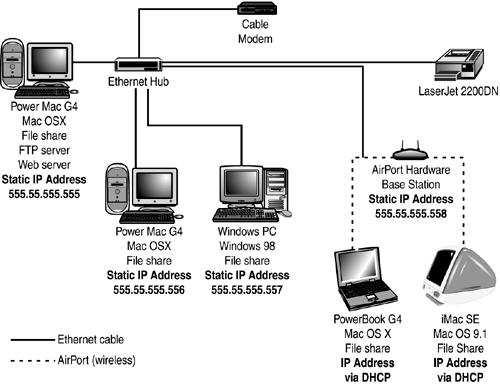| Before you implement a network, you need to design the network you want to create. As a starting point, answer the following questions: What kind of services do you want to provide over the network? Will you provide file serving? Do you want to share an Internet connection? How about FTP or Web services? The answers to these questions will drive the rest of your network design. For example, if you plan on sharing an Internet connection, you will most likely want to include a hub that can act as a DHCP server. How many devices do you want to be on the network? The devices for which you plan must include all of the workstations on the network as well as shared devices, such as printers, modems, and so on. The answer to this question determines how many access points into the network you will need to provide. How will you connect the devices together? For example, will you use Ethernet for all devices or will you include an AirPort hub (hardware or software Base Station) in the network? The answers to these questions determine the connecting devices you will need to use, such as Ethernet hubs, AirPort Base Stations, and so on. Who will need access to the services you are providing? How will they connect to the network? The answers to these questions help you identify the users on your network. What are the security implications of the services you are providing on the network? This question should drive you to make sure that you protect machines that will have access to the network. For example, you need to be very careful about providing FTP access to machines on which sensitive or critical data is stored. There are security concerns with any network service you provide; you should understand these when you design your network so that you will know how to provide proper security for it.
 To learn how to use a network to share an Internet connection, see Chapter 26, "Sharing an Internet Connection," p. 755. To learn how to use a network to share an Internet connection, see Chapter 26, "Sharing an Internet Connection," p. 755.
 To learn how to protect your network from attack, see "Defending Your Mac from Net Attacks," p. 800. To learn how to protect your network from attack, see "Defending Your Mac from Net Attacks," p. 800.
As you answer the previous questions, you should be ready to design your network. You should document your network design with at least a simple sketch of the network, the list of the devices you need to include on the network, and so on. Also, include the services you will be providing from specific machines on the network. An example of a design for a small office network is shown in Figure 25.1. Figure 25.1. A simple network design document, such as this one for a small office network, can aid network design, implementation, and maintenance.
TIP Having your network design documented will enable you to expand it more easily when you outgrow it. It is much simpler to determine what needs to be done to expand a network when you see it on paper than it is by looking at it in the "real world." (Besides, unless all the machines are in the same room, you probably won't be able to see them all at the same time anyway.)
|
 To learn how to use a network to share an Internet connection,
To learn how to use a network to share an Internet connection, 